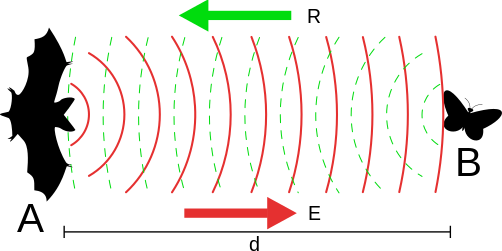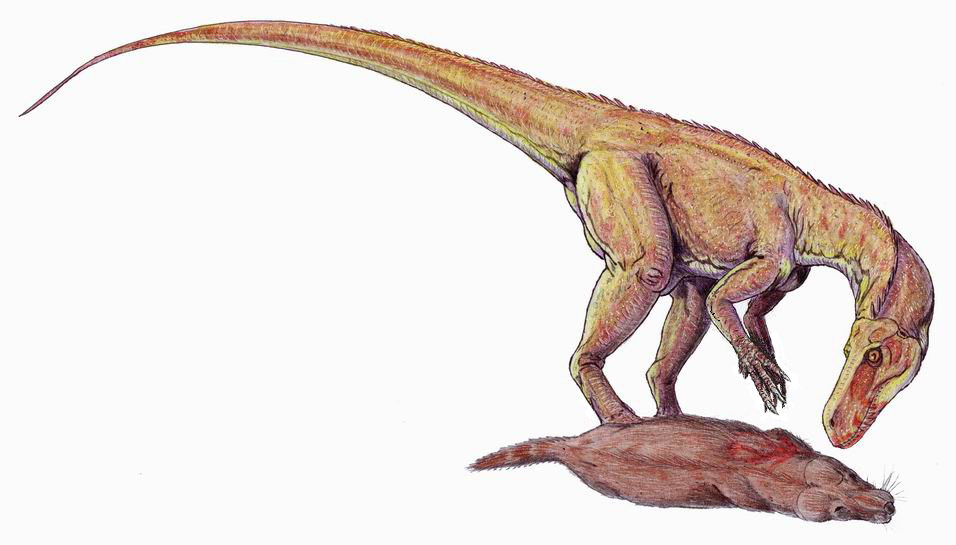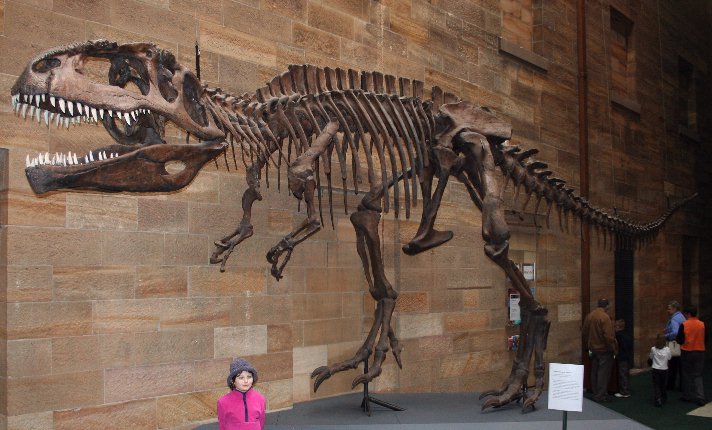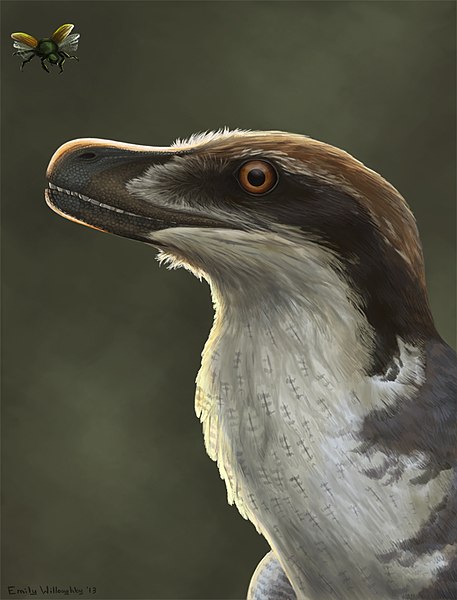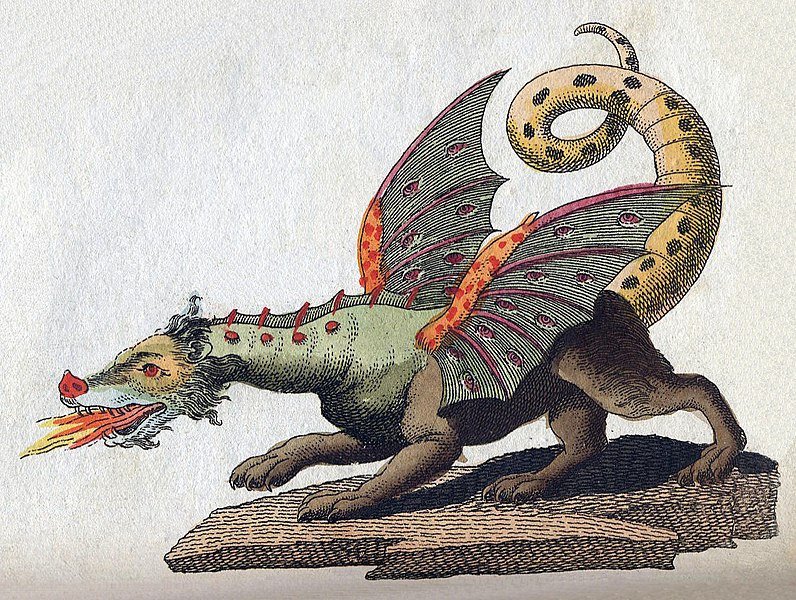Harvest Day, typically known as Halloween (or "Free Candy Day" as actress Cozi Zuehlsdorff calls it) is officially here! Can you believe it? Anyway, originally, I was going to do an article about raccoons today, but I accidentally deleted it, so not only will I have to do that another time, but I'll also have to use an article I intended for a later date. Not that this is necessarily a bad thing, because I was rather looking forward to publishing it. As a hardcore dinosaur enthusiast, I love dinosaur
movies and get really excited when they finally come out. After Walking with
Dinosaurs: The Movie, I thought I'd have to wait until Jurassic World
comes out for my next dino-flick. That was until I accidentally bumped into the
movie I am going to talk about today: Dinosaur Island. But before we get
to that, it's time for. . .
Days till:
It is: Harvest Day!
It is: 2 days till Daylight Savings Time Ends (BE SURE TO CHANGE THE TIME ON YOUR CLOCKS!!!)
It is: 11 days till Veteran's Day
It is: 27 days till Thanksgiving
In the Spotlight:
Unfortunately, no news concerning any of the movies I've been talking about to share today.
Topic of the Week by Christian Ryan
Have you ever wanted to escape from the troubles of the real
world and into a world of amazing natural wonders, crystal caves, pack-hunting
raptors, troublesome natives, ravenous Tyrannosaurus and other dangerous
creatures? No? This is what happened to Lucus Winton in the upcoming/new movie, Dinosaur
Island, which came out sometime this November. This film is about a 13-year
old A-grad student who boards an airline so that he can see his father, who is
serving in the military overseas. En route, the plane finds itself in a strange
thunderstorm. Lucus is thrown into a daze and is knocked unconscious. By the
time he awakes, he finds himself on a sandy beach on a beautiful tropical
island, with no plane or other people in sight. As he treks inland, he finds
that he is on no ordinary island – this is an island inhabited by a myriad of
extinct and exotic dinosaurs and other creatures, many of them dangerous. Soon
he finds a 15-year old girl by the name of Kathryn “Kate” Rose Thompson who has
lived on the island for many years. Together, they start an adventure in the
hopes of being able to return home. Check out the trailer for the movie below.
 |
| After Lucus meets Kate, the two of them embark on an incredible adventure across Dinosaur Island in the hopes of returning home. |
 |
| This is the balcony of Kate's tree house. |
For starters, I was surprised how little publicity this movie had! I only found out about it on YouTube when I was looking through someone's channel; on the channel was the trailer for the film Dinosaur Island. I mean, there's a website, a Facebook page, an Instagram profile and a YouTube account dedicated to this film, but still, there wasn't really much advertising for it. Regardless though, I'm so glad I bumped into it – it was a very enjoyable movie for me; a well-spent hour and thirty minutes of my time that I didn't regret.
 |
| Here are some sketches of a few of the incredible dinosaurs that appear in Dinosaur Island. |
Now back to the basic plot, as described two paragraphs ago,
Lucus winds up on an isolated island filled with dinosaurs and other strange
creatures. In fact, he almost meets his demise at the claws and teeth of a pack
of raptors fairly soon after his arrival on the island before being rescued by
Kathryn Rose Thompson. (Though she prefers to be called “Kate”) It's apparent
that Kate has been living on the island for a long time and knows a lot about
its prehistoric inhabitants. Her age is indicated when she says that she'll “be
turning 16”, meaning she is 15 years old. Lucus finds it odd that Kate doesn't
have a phone and that she was born in the early-mid 1900's, even though he is
from 2014. As Kate lectures to him, she reveals that “I have a theory that we
are in a place between places.” This becomes apparent throughout the course of
the movie – not only are dinosaurs present on the island, but human tribes,
extinct elephants and countless ship and plane wrecks.
The thunderstorm – or “mist”, as it's referred to in the
movie – is a strange natural phenomenon that's responsible for bringing the
creatures and other objects from other times and places to the island. So in a
sense, it's like a primeval Neverland. Ever since Kate arrived on the island
several years before, she has devoted her time to studying the dinosaurs. She
has identified many of the species on the island and collected samples of some
of the island's smaller residents. She records everything she learns in her
journal. She even has a friend on the island named Mimos, a bird-like dinosaur
called Sinornithosaurus who can mimic everything he hears. While Kate is
happy with her lifestyle, Lucus wants none of it; he wants to get back home.
Kate is rather reluctant to return home, herself, but after some convincing
from Lucus (and a mishap or two with a native tribe), she eventually decides
that this is what she wants as well. The two of them have an amazing and
dangerous adventure across Dinosaur Island to reach what might be their only
way back home.
 |
| Lucus is somewhat startled by Mimos at first, to say the least. |
I won't go through any more of the movie because I don't want
to spoil it. But I'm not nearly finished with my overview of this film! On
their journey, they come across loads of bizarre, and often times dangerous,
animals and plants. A major shocker for me was the complete lack of comments
concerning evolution and millions of years to my recollection! This is extremely
rare for movies like this!
 |
| Many dangerous predators, such as Tyrannosaurus rex, stalk the island. |
While many of the carnivorous dinosaurs that appear
on screen are feathered and there is a mention of some of them being bird-like,
I don't recall there being anything specifically saying they are related to
birds. (As I will state in an upcoming article, neither the Bible
or science are against the notion of feathered dinosaurs) Most of the creatures
in the movie are left unidentified, however I will now take this time to go
through the main creatures and minor creatures who only appear for a few
seconds on screen.
Main Creatures
Note: I've only seen the movie once, so I might have
missed a few creatures that appear in the film, but this list covers most of
them.
Dromaeosaur (Casuaraptor)
 |
| With needle-sharp teeth, grasping forearms and wicked enlarged toe claws, packs of Casuaraptor are dangerous predators. |
The first creatures Lucus comes across on Dinosaur Island are
a ferocious pack of dromaeosaurs, more commonly known as raptors. The
dromaeosaurs aren't specifically identified in the movie, but the movie's
website reveals that their genus name is Casuaraptor. As you might have
guessed based on the coloration and name of these dinosaurs, they are strongly
based on the appearance of the modern cassowary bird in Australia. Even though
they a raptor called Casuaraptor doesn't exist in the real world (only
on Dinosaur Island), it is extremely similar to other known species of
dromaeosaurs, such as Deinonychus, Achilibator or Austroraptor.
Like other raptors, Casuaraptor possess dozens of needle-sharp teeth,
dexterous hand claws, a stiff tail for balance while running and a feature all
raptors are known for: a retractable enlarged toe claw on each foot for
finishing off prey. Casuaraptor often hunt in packs to increase their
chances of a successful hunt. This species of raptor is attracted to the color
blue, especially during the mating season. Male raptors will seek out blue
objects to impress potential mates. Kate and Lucus better watch their backs,
because roves of Casuaraptor are stalking Dinosaur Island for their next
meal!
 |
| Casuaraptor hunt in deadly packs and are relatively intelligent. |
Mimos (Sinornithosaurus)
 |
| Mimos is a Sinornithosaurus who can replicate anything he hears. |
Kate's best animal friend on the island is a Sinornithosaurus
called Mimos. Sinornithosaurus is a member of the dromaeosaur family
(like Casuaraptor) but is smaller – in the movie – has a feathery wing
on each limb, enabling it to glide. Mimos gets his name from his amazing
ability to mimic any sound he hears, whether it be a a bird, another dinosaur
(including T. rex) or even the phrase “That is Correct.” He may be small, but
he is a loyal friend to Kate, and Lucus once he arrives on the island, staying
by their side till the very end.
Iguanodon
 |
| Iguanodon are one of Kate's favorite species. |
These are the third species of dinosaur Lucus meets on
Dinosaur Island. They live in herds and are one of Kate's favorite types of
dinosaur. When she is introducing Lucus to a herd of Iguanodon, they get
the chance to pet a friendly 10-day old baby.
Carnivorous Plants
 |
| Even the plants of Dinosaur Island have their eyes on you! |
On Dinosaur Island, it isn't just the dinosaurs you have to
be wary of; carnivorous plants lie in wait. Fortunately, Kate knows how to spot
them before they attack. These plants are quite peculiar, as they have eyes to
help them spot their prey. Once spotting it, they will use their dexterous
vines to latch onto unsuspecting prey before pulling it to its demise. In order
to kill the plant, you need to wound its “head”.
Arthropleura
 |
| Arthropleura has always been an object of curiosity for Kate. |
Kate collected the egg of an Arthropleura sometime
before Lucus arrived on the island. It hatched after Lucus arrived and gave him
and Kate quite a scare. Up until this time, even Kate had never seen one up
close before. Unfortunately for Lucus, the centipede-like creature Kate now
possessed was only a juvenile. Arthropleura was the largest terrestrial
invertebrate that ever lived; it was ten feet in length! That's the length of
an average car! In addition to large size, Arthropleura also possesses
huge pincers that – in the movie – give the creature a very venomous bite. They
also are portrayed as vicious carnivores, whereas in real life, they were
vegetarian.
| This is a full-grown Arthropleura. |
Pterosaurs (Alata dentatus)
 |
| These beautiful Pteranodon-like Alata dentatus can soar effortlessly through the heavens. |
Pterosaurs, like Alata dentatus, were not dinosaurs, but flying reptiles. They came
in all shapes and sizes. There is a flock of them that appears in the movie
(one of which befriends Lucus and Kate during a event with a native tribe and
is nicknamed “Junior”). These beautiful creatures fly on large flaps of wing
membranes stretched between their extremely long “pinky” finger and their feet.
Up until adulthood, the young bear fluffy fur-like structures on their bodies.
I was unable to precisely identify the pterosaurs in the movie, as they appear to
have a combination of features from various species. They look most like a Pteranodon,
but have toothed beaks and a long tail, two things real life Pteranodon
did not possess. However, just for fun, I gave them a name of my own creation: Alata dentatus, which means "winged and toothed" in Latin. The pterosaur named Junior is quite friendly and playful
toward Lucus and Kate and might be crucial to them surviving at some point on
their adventure.
Tyrannosaurus
 |
| Tyrannosaurus rex is Dinosaur Island's apex predator with a weight of around six or seven tons and a bone-crushing bite. |
No dinosaur ecosystem is complete without its apex predator,
and perhaps one of the best predators to fill this role was Tyrannosaurus
rex. T. rex doesn't have a “huge” part in Dinosaur Island, but
when he does make an appearance, he is bound to give Lucus and Kate a run for
their money (and lives!). This colossal predator stands 18 feet tall at the top
of its head, 40 feet from nose to tail and weighs seven tons! Its jaws are up
to four feet long and bear the strongest bite force of any animal ever to walk
the earth, living or dead! Its strong legs allow it to run up to 25 mph in
pursuit of prey. One of the funniest parts of the film was when Lucus sees the
T. rex for the first time as it exits the forest. He freezes instantly. When
Kate asks Lucus what he's doing, he responds, “It can't see us if we don't
move.” Then Kate responds by saying, “Where did you get a ridiculous notion? He
can see you just fine!” Of course, this an obvious nods of one of my favorite
movies, Jurassic Park, in which Dr. Alan Grant states that T. rex can
only see moving objects. However, this idea is refuted both in the Jurassic
Park franchise (that topic is beyond the scope of this article) and in Dinosaur
Island. If Tyrannosaurus is on the hunt, you'd best better run the
opposite direction and hope he's not hungry!
Minor Creatures
Note: Several other dinosaurs and other creatures appeared
in Dinosaur Island, but they were unidentified and only appeared on
screen for a few seconds. Some I was able to identify, while others I wasn't.
Since I only saw the movie once, this list might be incomplete, but it gives a
rough idea of what other interesting animals live on Dinosaur Island.
 |
| Guanlong is one of the few minor creatures that I could find a picture of. |
- Guanlong
- Unidentified Macronaria Sauropod
- Unidentified Diplodocid
- Stegosaurus
- Pachycephalosaurus
- Stegodont
- Unidentified Dromaeosaur
- Parasaurolophus
- Triceratops
- Giant Spider
 |
| Herds of several minor species, such as Stegosaurus, Pachycephalosaurus (left) and Parasaurolophus (far left, background) stampede away from a hungry Tyrannosaurus. |
In summary, Dinosaur Island was a very enjoyable and
exciting movie to watch. As of the time I am writing this, it is very hard to
find, but if you are fortunate, you might be able to see it on YouTube. If
you're able to, be sure to watch this movie. Prepare to go on the dinosaur adventure
of a lifetime with Lucus and Kate, as they try to escape the dangerous yet
beautiful Dinosaur Island!
 |
| Do these beautiful crystal caves hold the secret to allowing Lucus and Kate to return home? Watch the movie to find out! |
References:
Disclaimer: Many (or in some cases all) of
the photographs and images above are not mine. If you own one or more of them
and would like them to be removed, politely let me know via one or both of the
email addresses above.



_poster.jpg)

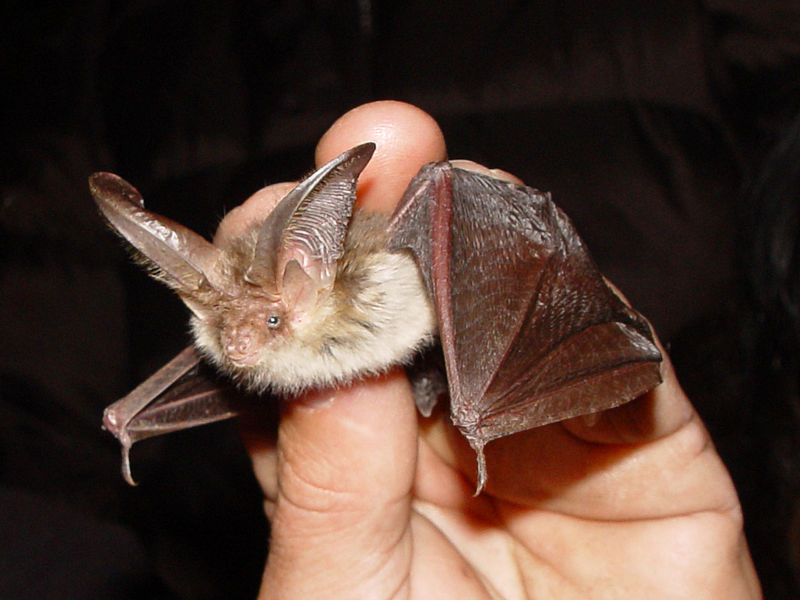

.jpg/450px-Bat(20070605).jpg)

